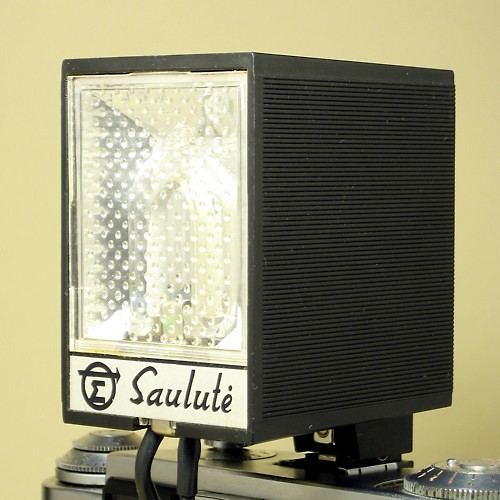Difference between revisions of "Saulutė"
(various) |
|||
| Line 1: | Line 1: | ||
{{Flickr image | {{Flickr image | ||
| − | | image_source=http://www.flickr.com/photos/35573024@N03/3911431417/in/pool- | + | | image_source=http://www.flickr.com/photos/35573024@N03/3911431417/in/pool-camerawiki |
| image=http://farm3.static.flickr.com/2474/3911431417_81517edfa5.jpg | | image=http://farm3.static.flickr.com/2474/3911431417_81517edfa5.jpg | ||
| image_align=left | | image_align=left | ||
| Line 7: | Line 7: | ||
{{br}} | {{br}} | ||
| − | '''Saulutė''' | + | '''Saulutė''' — the name means daisy in Lithuanian — electronic [[flash]]es were made by the V.I. Lenin Calculating Machines Factory of Vilnius in the Soviet Socialist Lithuanian Republic. Two types were marketed in 1970s and 1980s. |
| − | The '''Saulutė''' was a simple flash unit similar to the popular [[FIL|FIL-41]], Foton or Chaika-2 flashes - it was powered with 220 V AC mains, used an U-shaped tube giving it a guide number of 19 m for 100 [[film speed|ASA]] film (16 m for 65 [[film speed|GOST]]) and lighting angle of 60 degrees; it could be synchronized by both the [[hot shoe]] or a fixed sync cord. The flash had dimensions | + | The '''Saulutė''' was a simple flash unit similar to the popular [[FIL|FIL-41]], Foton or Chaika-2 flashes - it was powered with 220 V AC mains, used an U-shaped tube giving it a guide number of 19 m for 100 [[film speed|ASA]] film (16 m for 65 [[film speed|GOST]]) and lighting angle of 60 degrees; it could be synchronized by both the [[hot shoe]] or a fixed sync cord. The flash had dimensions 73×50×88 mm and weighted 300 g. Two variants of the Saulutė existed - one had a rotating calculator for establishing the correct exposure, the other - a simple chart. |
| − | The '''Saulutė-2''' was a more advanced construction - its head could be rotated up to 90 degrees to the sides or 60 degrees upwards. The flash was powered by | + | The '''Saulutė-2''' was a more advanced construction - its head could be rotated up to 90 degrees to the sides or 60 degrees upwards. The flash was powered by 220V AC mains (or a 300V DC battery power pack), had a guide number of 21m for 100 ASA (18m for 65 GOST) and lighting angle of 50 degrees. It was synchronized by a hot shoe. The flash had dimensions of 71×57×179 mm and weighed 400g. |
== Links == | == Links == | ||
Revision as of 15:01, 9 April 2011

|
| An 1979 Saulutė (with a revolving calculator at the back). |
Saulutė — the name means daisy in Lithuanian — electronic flashes were made by the V.I. Lenin Calculating Machines Factory of Vilnius in the Soviet Socialist Lithuanian Republic. Two types were marketed in 1970s and 1980s.
The Saulutė was a simple flash unit similar to the popular FIL-41, Foton or Chaika-2 flashes - it was powered with 220 V AC mains, used an U-shaped tube giving it a guide number of 19 m for 100 ASA film (16 m for 65 GOST) and lighting angle of 60 degrees; it could be synchronized by both the hot shoe or a fixed sync cord. The flash had dimensions 73×50×88 mm and weighted 300 g. Two variants of the Saulutė existed - one had a rotating calculator for establishing the correct exposure, the other - a simple chart.
The Saulutė-2 was a more advanced construction - its head could be rotated up to 90 degrees to the sides or 60 degrees upwards. The flash was powered by 220V AC mains (or a 300V DC battery power pack), had a guide number of 21m for 100 ASA (18m for 65 GOST) and lighting angle of 50 degrees. It was synchronized by a hot shoe. The flash had dimensions of 71×57×179 mm and weighed 400g.